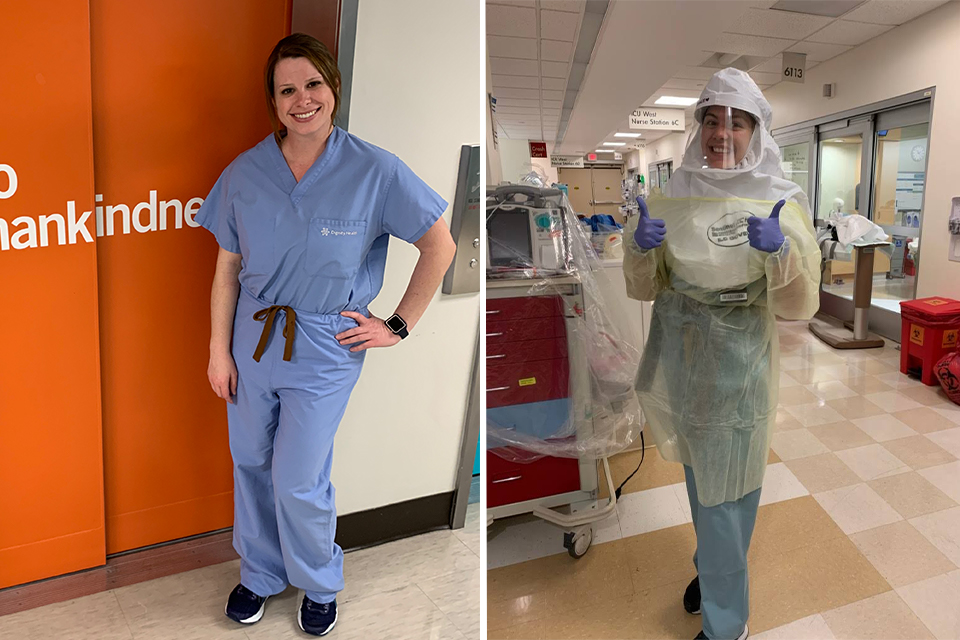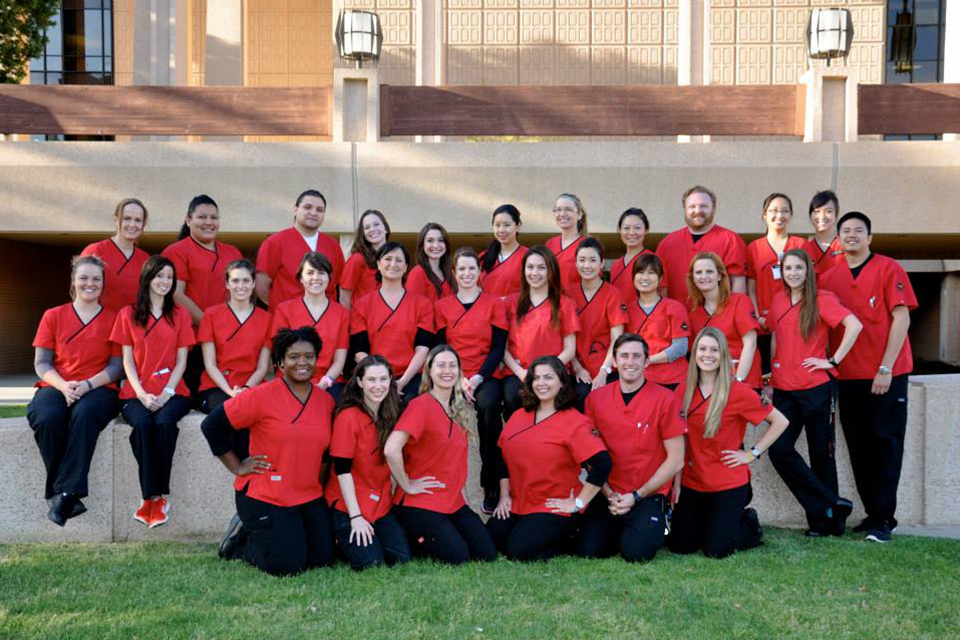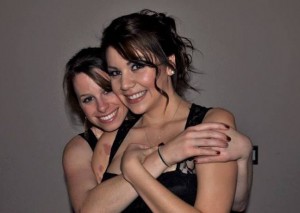For Two CSUN Nurses, the Reward Is in the Impact Made

CSUN alumni Julianne Humason, left, and Nathalie De La Peña have provided care as nurses during the COVID-19 pandemic. They are also faculty members at CSUN. (Photos courtesy of Julianne Humason and Nathalie De La Peña)
Instinct tells nurse Julianne Humason to walk inside the room every hour.
But for her safety and the safety of others, she stops at the window. Wearing a gown that was recently washed and the lone hairnet and pair of booties she has been issued for her shift, she looks inside to check on a patient who is lying in a bed fighting COVID-19.
She waves from beyond glass instead of standing by his side.
He can’t see behind the N95 mask covering her mouth, but there’s a smile.
The distance from patients is one of the most emotionally taxing parts of the job — a job that she calls perfect for her because she always wanted to take care of people.
But by limiting visits, she limits her exposure.
This whole hospital unit, which she was floated to for the day, is COVID-19 positive. She’s nervous.
“There’s the overwhelming fear that you’re going to bring something home,” said Humason ’14 (Nursing). “I think most nurses aren’t as worried about getting sick themselves. Most of my co-workers and I are scared we’re going to bring something home to our families. We signed up for this. We wanted to be nurses, but our family are not nurses. They’re not on the front lines and we’re just so scared we’re going to bring something home. So it’s been very stressful.”
Humason doesn’t sleep well.
She lives at home with her parents who are both in their 70s. The CSUN alumna continued her education after earning her bachelor’s degree in 2014 and received a master’s degree from UCLA six months ago. Afterward, she moved in with her parents to save some money.
Because of her job at a Los Angeles-area hospital and the risks associated with it, when she comes home from work, Humason is quarantined in her bedroom — separated from her parents who are so close by but divided by a wall.
They’ll text or call from inside the same house. Or Humason will open the window of her room that leads to the backyard and speak to her parents, Mike and Kathi, who are outside.
Humason has a makeshift kitchen in her room. She has a Keurig and George Foreman Grill.
“I tried making eggs this morning. It didn’t work out so great. They kind of kept sliding in place, and I tried to close the thing as fast as I could,” she laughed.
Dad will sometimes make dinner for Humason, 30. He’ll knock on the door, then leave the food in a tray on the ground.
She’s drained.
Yet Humason finds reward in the work.
“I feel I’m playing a part in this pandemic,” Humason said. “I don’t know if I could just stay home. I mean I know (if I stayed home) that’s still doing a part (to slow COVID-19). But I still want to help people and take care of them. So, I’m glad I became a nurse.
“Taking care of people, making them well, taking care of them when they’re sick, it’s the best job. And when you finally do get to see them go home and go back to their families and you see them get better, it’s the best feeling in the world.”
Nathalie
It’s referred to as the “resilience room.”
It was the waiting room at the hospital, but with fewer visitors because of COVID-19 precautions, it’s where nurses, anxious about the virus and the potential of acquiring it from treating a patient, have the opportunity to voice their fears and concerns. It’s also a gathering point where nurses can convene and get a cup of tea, a massage or just vent and de-stress.
In huddles outside the room, doctors and administrators speak to the nurses to assure them that the hospital is taking precautions to ensure their safety. But they’re also game planning in case of a surge.
CSUN alumna Nathalie De La Peña ‘14 (Nursing) works in a supervisory role as a charge nurse at a Los Angeles-area hospital. When there is need, she fills in and provides care as a nurse.
She’s on both sides — being a rock for employees and for patients.
But she feels apprehension as well and is coping with it the best way she can.
“I think it’s always scary to deal with something of the unknown, but in my position, I had to be there for my staff and kind of figure out a way to work around this,” De La Peña said. “Keeping busy for me and figuring out how I’m going to keep everyone else safe kind of helped ease my own anxiety, fear.”
De La Peña, 29, lives by herself. It’s a blessing and a curse, she said. She lives in an apartment in self-isolation.
She is normally close to her family — her sisters and parents — but hasn’t seen them in a few months. However, being away from them, because she is on the frontlines as a health care worker, reduces their risk of acquiring the virus.
So they FaceTime.
“Before this I would be at their house twice a week. So it’s definitely been hard,” she said. “I have really high anxiety, too, so I just try to stay busy and not let my mind wander and just know that it’s for the best.”
The COVID-19 unit at her hospital was opened in early March.
Patients can see the reassuring smile of a nurse at De La Peña’s hospital. The nurses utilize a PAPR, which is a respiratory protection system, instead of N95s that hide the mouth. A PAPR has a clear shield.
But there are times when one has to put on a strong face.
De La Peña works the night shift, when there are fewer nurses on the floor. She is a Spanish speaker and has been called away from her administrative responsibilities at times to provide care and to communicate with patients who don’t speak English.
In April, she cared for a man who is originally from Guatemala. He is in the country alone. He expressed to her that he was studying for the U.S. Naturalization Test. The man also told her he was scared about his condition.
He came into the hospital concerned about a cough. He was later diagnosed with COVID-19. She explained to him that she was there to make him better.
“He literally grabbed my hand and said, ‘If I die, no one’s going to care, and no one’s going to know because my family’s not here,’” De La Peña recalled. “And that just broke my heart. And I said, ‘No. We’re going to try to find someone in Guatemala. Do you have their phone numbers?’ And we reached out to them.
“And I told him, ‘Don’t worry. I’ll be here. I’ll check in on you every day.’”
De La Peña said there are moments that make her proud of what she is doing and moments that justify the long hours she studied to get into this line of work.
“Everyone that didn’t shy away from it,” she said on what has inspired her. “We didn’t have an option, and all my nurses were willing. They were scared but at the end of the day they were willing, and they were taking care of these patients. We’ve discharged a lot of patients home, and they haven’t come back to us.”
The Classmates

The 2013-14 CSUN Nursing Program cohort.
Humason and De La Peña were part of the same cohort that entered the CSUN Nursing Program in 2013 — a group of 30 students who were putting in 60, 70, 80 hours per week in training to fulfill the dream of a career in the medical field.
The cohort was similar to a family — they learned together, worked together and even argued with each other.
One time, the CSUN students chose to do a suicide awareness flash mob for a class project. The project also honored CSUN nursing professor Rebekah Child’s sister, Jacqueline, who in 2006 took her own life at the age of 38.
The group worked out a dance routine to the Katy Perry song, “Roar” — an inspirational pop tune with the chorus:
I got the eye of the tiger, a fighter
Dancing through the fire
‘Cause I am a champion, and you’re gonna hear me roar
“Oh God, I can’t listen to it anymore,” Humason remembered with a laugh. “Not one of my favorite songs.”
“We got ticked off at each other doing the flash mob and trying to learn the dance moves,” Humason said.
But there were only a few moments of tension. The effort and the purpose brought everyone closer, she said.
De La Peña, around this time, dealt with her own personal grief. Her grandmother Amalia passed away from cancer.
“She was upset and everything, but she just always put on a brave face and kept working and moving forward. She’s really strong,” Humason said.
De La Peña, however, admitted that the loss had a negative effect on her grades.
The path toward earning a degree had already been difficult. De La Peña was paying her way through nursing school and commuting 25 miles through maddening traffic each way from Northridge to Inglewood. Focused on her education, she wasn’t working and thus was relying on student loans to help take her to the finish line. And because of her nursing education, she was accompanying her family during hospital visits to give them a better understanding of Amalia’s treatment.
“I never got a break,” De La Peña said. “But you can’t say those things because I didn’t want to verbalize it and have it stop me. Because at the end of the day it was my goal to finish and that’s what my family wanted.”
The camaraderie within the cohort served as a positive distraction during this time, she said.
The cohort remained close after graduation, especially with Child. Members would go to lunch with Child. They even threw her a baby shower.
“I just love them so much, I can’t stand it,” Child said. “They just will always hold a very special place in my heart. Nursing students are special, especially because they’re cohorted. They start out so nervous and afraid, and you really have to kind of swaddle them and put them near your bosom and sing them lullabies because they’re just like one giant spazzy nerve. And it was just really fun to see them go from that tightly wound group of students to amazing professional, competent nurses.”
The 2013-14 academic year was Child’s first teaching at CSUN. The experience — from the energy the students had and dedication they showed, and the stories of their backgrounds and challenges — lit the fire for what has been more than a half-decade of educating students at CSUN.
The Teachers
When Child needs professors for the program, she reaches out to her former students. Ten of her alumni taught during the 2019-20 academic year.
Last summer, she reached out to Humason and De La Peña to teach.
Why?
“Because they’re rad,” Child said. “Because I know they enjoy teaching. I know they enjoy students. I know they would enjoy the opportunity.”
De La Peña taught the program’s Community and Population Health Nursing and Lab class, which focuses on population-based nursing practice, including health promotion, risk reduction and disease prevention across the lifespan of diverse individuals, families, and communities.
On March 11, CSUN shifted to virtual classrooms in response to the pandemic. Stay at home orders and social distancing presented a challenge for students to do community outreach.
Yet late in the semester some of De La Peña’s students volunteered for COVID-19-related projects in South El Monte and at Children’s Hospital Los Angeles. Other students couldn’t volunteer because they work in hospitals and nursing homes where people have COVID-19.

Humason and De La Peña started their friendship as classmates at CSUN and now teach at the university.
“The whole cohort actually had those opportunities and didn’t back down,” De La Peña said. “They were willing to help the profession that they’re coming into, and that just makes me really proud because knowing that this new generation of nurses is so proactive and so resilient, and their willingness to help just makes it better.”
Humason has taught at CSUN for a calendar year.
At the beginning of the semester, students received hands-on experience at a hospital giving patients medication and doing wound care. Soon after the pandemic hit the U.S., the hospital no longer allowed students inside because of the potential risk of exposure and spread.
Learning shifted to online until another Los Angeles-area hospital allowed students in for their clinical research. However, students weren’t allowed to give patients direct care.
Humason found a solution
After receiving permission from her hospital and Child, she offered some students the opportunity to get the hands-on experience at a Thousand Oaks office where she has a second job working as a nurse practitioner.
Students came to the office, and wearing protective equipment, practiced skills on each other. Humason brought hot dogs and oranges for students to practice injections. A doctor at the office helped out on his day off and showed students how to take blood pressure and other medical techniques.
“I’m proud of them for hanging in there because they could have just said, ‘You know what? Forget it.’ They stuck through it,” Humason said.
Child made a similar statement about Humason and De La Peña.
“They really epitomize what nursing has historically and will always be,” Child said. “You do what you need to do to get the job done. It’s the same in the hospital. You have a patient who needs something, and you don’t have all the resources, you’re just resilient. Most likely the students will not appreciate it until they themselves are nurses, maybe five years down the road.
“They’re going to see that those women really went above.”
The Next Generation
One of the final assignments in Humason’s class was a reflective essay. She asked her students to express how they feel about what is going on in the world and if they still want to be nurses.
One afternoon after the semester ended, Humason was sitting in her bedroom — the one with the George Foreman Grill and Keurig. She looked through some of the essays and expressed how impressed she was by the honesty and emotions of the words. She pulled up an essay from a student who had been afraid of going into a hospital during the pandemic.
The essay reads:
“I remember the commitment I was making, and I was confident making it. However, the current climate in America brings up questions for me: Did we sign up to protect others despite the lack of resources and our nation’s ability to protect us? If we are protecting the world, who is protecting us? But I’m absolutely confident in my decision in becoming a nurse, and I believe being at the frontlines of the pandemic to this degree is rewarding and noble.”

 experience
experience